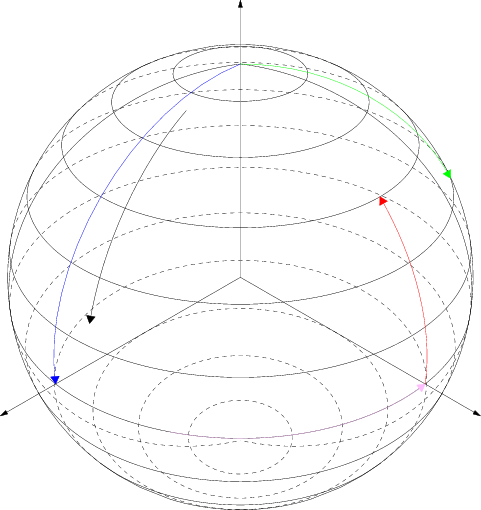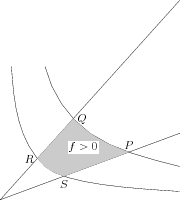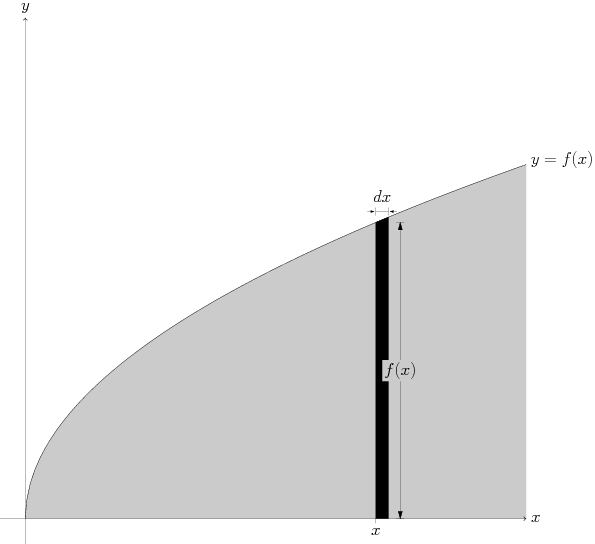| Download
Asymptote graphics package demo in sage worksheet
Project: 📚 MOOC Companion
Path: Public/asy-demo.sagews
Views: 617Asymptote Vector Graphics Language in a Sage worksheet
How-to:
asymptote calculation in a single cell of a .sagews file
%asy ... asymptote commandshave all cells in a Sage worksheet %asy mode by default:
%auto %default_mode asy
Tutorials and Examples
Extensive 109-page tutorial by Charles Staats III An Asymptote tutorial.
873 examples of Asymptote code Asymptote: The Vector Graphics Language
Asymptote References
Sourceforge: Asymptote: The Vector Graphics Language
GitHub: ASYMPTOTE
%auto %default_mode asy
In the Staats tutorial, examples begin by setting output format to .pdf. Omit that setting below, because %asy mode in a worksheet uses png output.
// say hello label("Hello default font"); // use larger and heavier font than the default label("Hello 18pt Helvetica", p = fontsize(18pt)+Helvetica( "m" , "n" ), (150,0));

// https://math.uchicago.edu/~cstaats/Charles_Staats_III/Notes_and_papers_files/asymptote_tutorial.pdf, p.13 // polygons unitsize(3cm); defaultpen(1); for (int n = 3; n <= 7; ++n) { draw(shift(2.2*n, 0) * polygon(n)); }

// spherial arcs // https://tex.stackexchange.com/a/125819/148481 import solids; import three; settings.render=0; settings.prc=false; currentprojection=perspective(1,1,1); size(18cm); // distances: radius and length real r=.4, ar=.5; // sphere to visualize the various arcs revolution S=sphere(O,r); draw(S.silhouette(),black+linewidth(.5pt)); draw(S,black+linewidth(.5pt)); // axes draw((0,0,0)--(0,ar,0),linewidth(0.5pt),Arrow3); draw((0,0,0)--(0,0,ar),linewidth(0.5pt),Arrow3); draw((0,0,0)--(ar,0,0),linewidth(0.5pt),Arrow3); /////////////////////////////////////////////////////////// /////////////////////// blue arc ////////////////////////// /////////////////////////////////////////////////////////// // starting point in spherical coordinates real theta=0, phi=0; real x1=r*sin(theta)*cos(phi), y1=r*sin(theta)*sin(phi), z1=r*cos(theta); // end point real theta=pi/2, phi=0; real x2=r*sin(theta)*cos(phi), y2=r*sin(theta)*sin(phi), z2=r*cos(theta); draw(arc((0,0,0),(x1,y1,z1),(x2,y2,z2)),blue+linewidth(1pt),ArcArrow3); /////////////////////////////////////////////////////////// ////////////////////// green arc ////////////////////////// /////////////////////////////////////////////////////////// // starting point real theta=0, phi=3*pi/4; real x1=r*sin(theta)*cos(phi),y1=r*sin(theta)*sin(phi),z1=r*cos(theta); // end point real theta=pi/3, phi=3*pi/4; real x2=r*sin(theta)*cos(phi), y2=r*sin(theta)*sin(phi),z2=r*cos(theta); draw(arc((0,0,0),(x1,y1,z1),(x2,y2,z2)),green+linewidth(1pt),ArcArrow3); /////////////////////////////////////////////////////////// /////////////////// other examples //////////////////////// /////////////////////////////////////////////////////////// // arc(center,starting point,end point)) draw(arc((0,0,0),(0,r,0),(0,r*cos(pi/4),r*sin(pi/4))),red+linewidth(1pt),ArcArrow3); // arc(center,radius,theta1,phi1,theta2,phi2) // almost like the blue arc but with phi=10 degrees and different ends draw(arc(O,r,20,10,70,10),black+linewidth(1pt),ArcArrow3); // almost like the black arc but with phi=30 degrees draw(arc(O,r,90,30,90,90),pink+linewidth(1pt),ArcArrow3);

// buildcycle // http://www.piprime.fr/985/official_asymptote_example-buildcycle/ /* This code comes from The Official Asymptote Gallery */ size(200); real w=1.35; path[] p; for(int k=0; k < 2; ++k) { int i=2+2*k; int ii=i^2; p[k]=(w/ii,1){1,-ii}::(w/i,1/i)::(w,1/ii){ii,-1}; } path q0=(0,0)--(w,0.5); path q1=(0,0)--(w,1.5); draw(q0); draw(p[0]); draw(q1); draw(p[1]); path s=buildcycle(q0,p[0],q1,p[1]); fill(s,mediumgrey); label("$P$",intersectionpoint(p[0],q0),N); label("$Q$",intersectionpoint(p[0],q1),E); label("$R$",intersectionpoint(p[1],q1),W); label("$S$",intersectionpoint(p[1],q0),S); label("$f > 0$",0.5*(min(s)+max(s)),UnFill);

// Pythagorean tree // http://www.piprime.fr/971/official_asymptote_example-PythagoreanTree/ /* This code comes from The Official Asymptote Gallery */ size(250); real a=3; real b=4; real c=hypot(a,b); transform ta=shift(c,c)*rotate(-aCos(a/c))*scale(a/c)*shift(-c); transform tb=shift(0,c)*rotate(aCos(b/c))*scale(b/c); picture Pythagorean(int n) { picture pic; fill(pic,scale(c)*unitsquare,1/(n+1)*green+n/(n+1)*brown); if(n == 0) return pic; picture branch=Pythagorean(--n); add(pic,ta*branch); add(pic,tb*branch); return pic; } add(Pythagorean(12));

// intro calculus diagram from // https://math.uchicago.edu/~cstaats/Charles_Staats_III/Notes_and_papers_files/asymptote_tutorial.pdf // page 48 // Basic settings size(21cm, 0); defaultpen(fontsize(16pt)); import graph; //Define the command drawshifted, to be used later void drawshifted(path g, pair trueshift, picture pic = currentpicture, Label label="", pen pen=currentpen, arrowbar arrow=None, arrowbar bar=None, margin margin=NoMargin, marker marker=nomarker) { pic.add(new void(frame f, transform t) { picture opic; draw(opic, L=label, shift(trueshift)*t*g, p=pen, arrow=arrow, bar=bar, margin=margin, marker=marker); add(f,opic.fit()); }); pic.addBox(min(g), max(g), trueshift+min(pen), trueshift+max(pen)); } //Save some important numbers. real xmin = -0.1; real xmax = 2; real ymin = -0.1; real ymax = 2; //Draw the graph and fill the area under it. real f(real x) { return sqrt(x); } path s = graph(f, 0, 2, operator..); pen fillpen = mediumgray; fill(s -- (xmax,0) -- cycle, fillpen); draw(s, L=Label("$y=f(x)$", position=EndPoint)); //Fill the strip of width dx real x = 1.4; real dx = .05; real t0 = times(s,x)[0]; real t1 = times(s,x+dx)[0]; path striptop = subpath(s,t0,t1); filldraw((x,0) -- striptop -- (x+dx,0) -- cycle, black); //Draw the bars labeling the width dx real barheight = f(x+dx); pair barshifty = (0, 0.2cm); Label dxlabel = Label("$dx$", position=MidPoint, align=2N); drawshifted((x,barheight) -- (x+dx, barheight), trueshift=barshifty, label=dxlabel, bar=Bars); //Draw the arrows pointing inward toward the dx label real myarrowlength = 0.3cm; margin arrowmargin = DotMargin; path leftarrow = shift(barshifty) * ((-myarrowlength, 0) -- (0,0)); path rightarrow = shift(barshifty) * ((myarrowlength, 0) -- (0,0)); draw((x, barheight), leftarrow, arrow=Arrow(), margin=arrowmargin); draw((x+dx, barheight), rightarrow, arrow=Arrow(), margin=arrowmargin); //Draw the bar labeling the height f(x) real barx = x + dx; pair barshiftx = (0.42cm, 0); Label fxlabel = Label("$f(x)$", align=(0,0), position=MidPoint, filltype=Fill(fillpen)); drawshifted((barx,0) -- (barx, f(x)), trueshift=barshiftx, label=fxlabel, arrow=Arrows(), bar=Bars); //Draw the axes on top of everything that has gone before arrowbar axisarrow = Arrow(TeXHead); Label xlabel = Label("$x$", position=EndPoint); draw((xmin,0) -- (xmax,0), arrow=axisarrow, L=xlabel); Label ylabel = Label("$y$", position=EndPoint); draw((0,ymin) -- (0,ymax), arrow = axisarrow, L=ylabel); //Draw the tick mark on the x-axis path tick = (0,0) -- (0,-0.15cm); Label ticklabel = Label("$x$", position=EndPoint); draw((x,0), tick, L=ticklabel);
